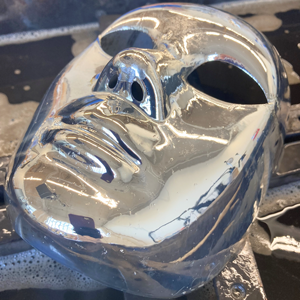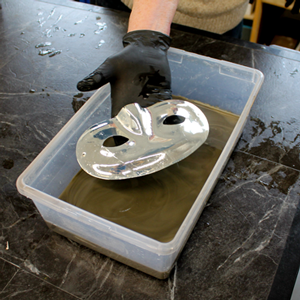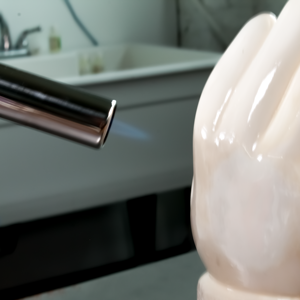Mirroring Plastic


You can deposit mirroring chemicals on any non-metallic surface. Whether you get a reflective coating – a true mirror – depends on several factors.
- The surface must be very high gloss - it must look like glass - if you want a truly reflective coating.
- The mirroring chemicals must flow evenly over the surface without beading up - as they do in this photo.
- There are many types of plastic. Some of them respond better to the mirroring process than others.
Types of Clear Plastic
We have not tried mirroring over every type of plastic, but our tests have shown that
- PETG (Vivak®) is the easiest plastic to mirror.
- Polycarbonate (Lexan®) is the next easiest.
- ABS mirrors well with our spray silver formulas but not our pouring silver formula.
- Acrylic (Plexiglas®) does not mirror well. We had some good results with Spray Silver but Pouring Silver produces a dull, mottled reflection.
- Commercial acrylic mirrors are made by evaporating aluminum metal in a vacuum chamber. We do not have the equipment to do this.
As always, the surface must look like glass if you want the silver to look like a mirror.
Tips for making plastic mirrors
Clean the plastic with isopropyl alcohol (rubbing alcohol) and then glass cleaner before mirroring even if it is covered with a protective film.
Spray Silver works better on plastic than Pouring Silver.
Use Century Clear Urethane, not Century Clear Lacquer, to create a clear protective backing for your plastic mirror.
Getting the chemicals to contact the surface
When the plastic is immersed in the mirroring chemicals they can't bead up and roll off. They are forced into even, direct contact with the surface.
Use a 3-D Glass Mirror Kit and pouring silver for small, non-acrylic items
We have instructions for using spray silver to dip larger items on our Dipping Chrome page
Use Wetting Agent to break the surface tension - see the photos below


Before
Water has a higher surface energy than plastic so the water molecules are more attracted to each other than they are to the plastic.


After
Wetting Agent lowers the surface energy (breaks the surface tension) of the water allowing it to flow over the plastic.





